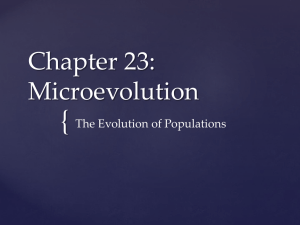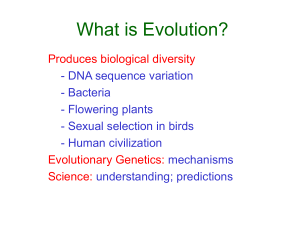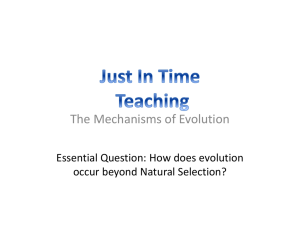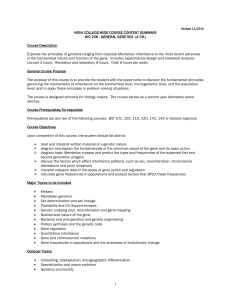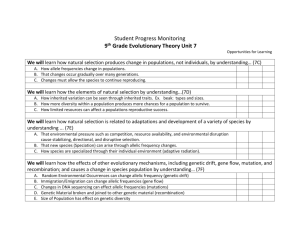Exam 2 Study Guide. Dr Sullivan.
advertisement
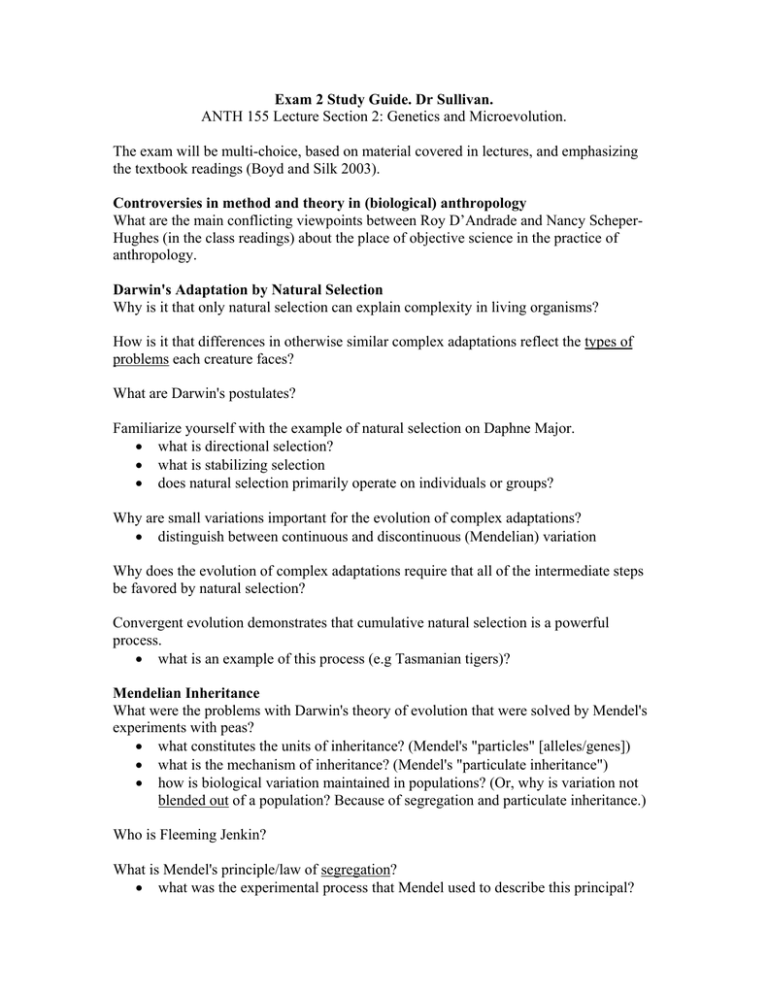
Exam 2 Study Guide. Dr Sullivan. ANTH 155 Lecture Section 2: Genetics and Microevolution. The exam will be multi-choice, based on material covered in lectures, and emphasizing the textbook readings (Boyd and Silk 2003). Controversies in method and theory in (biological) anthropology What are the main conflicting viewpoints between Roy D’Andrade and Nancy ScheperHughes (in the class readings) about the place of objective science in the practice of anthropology. Darwin's Adaptation by Natural Selection Why is it that only natural selection can explain complexity in living organisms? How is it that differences in otherwise similar complex adaptations reflect the types of problems each creature faces? What are Darwin's postulates? Familiarize yourself with the example of natural selection on Daphne Major. • what is directional selection? • what is stabilizing selection • does natural selection primarily operate on individuals or groups? Why are small variations important for the evolution of complex adaptations? • distinguish between continuous and discontinuous (Mendelian) variation Why does the evolution of complex adaptations require that all of the intermediate steps be favored by natural selection? Convergent evolution demonstrates that cumulative natural selection is a powerful process. • what is an example of this process (e.g Tasmanian tigers)? Mendelian Inheritance What were the problems with Darwin's theory of evolution that were solved by Mendel's experiments with peas? • what constitutes the units of inheritance? (Mendel's "particles" [alleles/genes]) • what is the mechanism of inheritance? (Mendel's "particulate inheritance") • how is biological variation maintained in populations? (Or, why is variation not blended out of a population? Because of segregation and particulate inheritance.) Who is Fleeming Jenkin? What is Mendel's principle/law of segregation? • what was the experimental process that Mendel used to describe this principal? Review the terms: • homozygous • heterozygous • dominant • recessive • genotye • phenotype Be able to draw a simple Punnett Square to describe an example of Mendelian inheritance. • what is the typical Mendelian genotype ratio for offspring of heterozygous parents: 1:2:1 • what is the typical Mendelian phenotype ratio for offspring of heterozygous parents: 3:1 Review: • DNA • chromosome • homologous chromosome • locus • allele/gene What is Mendel's law/principle of independent assortment? Review how gametes are produced in meiosis • what is crossing over? • how is meiosis related to Mendel's principles of segregation and independent assortment. Natural Selection, Sexual Selection and Kin Selection Review soapberry bug behavior as an example of NS • what is the selection pressure on male bug’s guarding behavior? Review inter- and intra-sexual selection – what is an example of each? Kin selection theory addresses the “problem of altruism” between related individuals • what is Hamilton’s rule? • what is the coefficient of relatedness? • what is inclusive fitness? Population Genetics: Hardy and Weinberg A population genetical definition of evolution: "a change in gene frequencies from one generation to the next". Review some of the problems in early 20th Century neo-Darwinism: • • Mendelian inheritance was seen as contrary to Darwin's theory of evolution by natural selection (why was this?: discontinuous vs continuous variation -> saltation) persistence of ideas of blending inheritance Review the principal insights of Hardy and Weinberg in 1980 • If you take a population and freeze it in time, and impose certain conditions on it; that reproduction is sexual and random between members of the population in the absence of any other “forces”; then the effects of sexual reproduction alone will result in a change of genotype frequencies in the next generation. If “conditions” remain the same, genotype frequencies will remain unchanged over subsequent generations - the population is said to be in (Hardy-Weinberg) equilibrium. Understand why genotype frequencies and gene (or allele) frequencies in a population are not the same thing. Familiarize yourself with how the Hardy-Weinberg equation (for a genetic locus with two alleles) is used to calculate the genotype frequencies and the gene frequencies in the example of the PKU population in the textbook. Referring to the PKU example in the textbook, understand how natural selection can change gene frequencies in a population. The "forces" of evolution that can change gene frequencies in a population are: • mutation • natural selection • genetic drift • gene flow Population Genetics II: The New Synthesis and Forces of Evolution What is the New Synthesis? (aka the Modern Synthesis and the neo-Darwinian Synthesis) • A merging of Mendelian inheritance, Darwin’s evolution by natural selection and the insights of population biology (evolution is a change in gene frequencies in a population). Who are Ronald Fisher, JBS Haldane and Sewall Wright? When Mendelian genetics was rediscovered, biologists at first thought that Mendelian genetics was incompatible with Darwin’s theory of evolution by natural selection. • review the genetics of continuous variation • continuously varying traits are affected by genes at many loci (not one loci as is the case with discontinuous Mendelian traits) • how does environmental variation further effect the expression of traits controlled by multiple loci? Selection does tend to remove variation from populations: • review how a very low mutation rate can maintain variation in a population, despite the depleting effect of natural selection Review genetic drift: • When populations are small, they are vulnerable to random effects caused by sampling variation. • in small populations, alleles frequencies can change between generations by chance alone • e.g. in normal segregation [meiosis] between generations (5 different offspring from 5 different pairs of parents could all receive the “a” rather “A” allele in a 2allele trait by chance alone) Chance environmental phenomena and events that affect the survival of phenotypes (individuals) can also result in genetic drift: • founder effect • genetic bottlenecks In small populations, genetic drift causes random fluctuations in genetic frequencies. • such fluctuations can result in alleles going to fixity after only a relatively small number of generations Genetic drift could only produce adaptations by chance: • we have seen that the probability of complex adaptations being caused by chance are very small • this means that genetic drift usually leads to maladaptation • genetic drift is unlikely to generate significant maladaptation in complex traits (like the eye)[traits that vary continuously and are affected by many loci] • so drift could cause changes in ABO blood type, but not eyes The opposite of genetic drift is gene flow • the movement of genes between populations • gene flow prevents speciation (e.g. modern human evolution) • these two opposing processes constitute important forces of evolution (with mutation and natural selection) Human Variation I: "Simple" traits How much human variability is due to genetic differences between people? • need to distinguish variation within groups and among groups The causes of human variation can be divided into: • genetic variation -> inherited genes • and environmental variation -> differences between individuals caused by environmental factors Complex traits like body mass and schizophrenia are influenced by genes and environment. Review the following examples of a human variability within groups caused by a single gene at one locus. Specific Language impairment: • why do about half of the offspring of people with SLI have the affliction? Harmful disorders that generally occur at low frequencies, like PKU, can be maintained in populations in a selection-mutation balance. Sickle Cell Anemia: • is maintained in populations exposed to malaria as a balanced polymorphism • because carriers enjoy a heterozygous advantage Non-insulin-dependent diabetes may exist in some populations because environments have recently changed and genes that were previously beneficial have not yet been eliminated (the mismatch hypothesis): • review the Nauru example • what is the thrifty genotype hypothesis? Review digestive capacity for lactose as an example of human variability between groups caused by a single gene at one locus. Review how genetic drift is an important factor that creates variation between isolated populations e.g.: • Old Order Amish • as opposed to Utah Mormons Review how current patterns of genetic variation reflect the history of migration and population growth in the human species. Human Variation II: Complex Traits and Race (Review B&S pp. 417 - 430) Review the issues related to genetic variation within groups. Review the issues related to genetic variation among groups. Why is the increase in stature that coincided with modernization evidence for the influence of environmental variation on stature? The Race Concept: • Why is there no single natural classification of the human species? • • • Why do racial classification schemes explain very little of the world's human genetic variation? Racial classification schemes don't represent natural biological categories. Races may represent important cultural categories.
